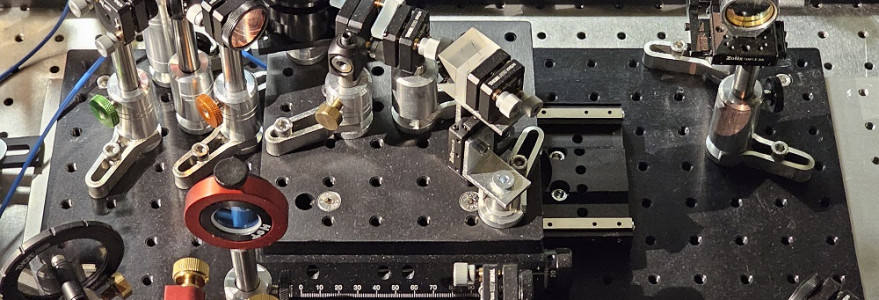Prof. Michał Parniak and Michał Lipka from the UW’s Faculty of Physics developed a quantum-inspired super-resolving spectrometer for short pulses of light. In the future the device can be miniaturized on a photonic chip and applied in optical and quantum networks as well as in spectroscopic studies of matter. The invention was presented by the researchers in “Optica”.
The super-resolving spectrometer for short pulses of light (SUSI) was designed in the Quantum Optical Devices Lab at the Centre for Quantum Optical Technologies, Centre of New Technologies and UW’s Faculty of Physics.
“The working principle of the SUSI device is very similar to the so-called quantum-inspired super-resolution methods in imaging. The greatest challenge was how to translate these ideas to the realm of time and frequency,” said Michał Lipka, a doctoral candidate at the UW’s Faculty of Physics, the co-creator of the device.
Colors bring information
The task of spectroscopy is to study the various colors, that is the spectrum, of light. A chemical substance will emit its characteristic colors by which it can be identified. Similarly, a distant star will also have a specific spectrum of light, through which we can understand its astrophysical properties such as size or age. Different colors of light are also used to transmit information over channels in fiber networks, similarly as different radio bands are used to transmit many channels at the same time. These optical channels are at the core of intercontinental optical networks, and are also essential for future secure quantum networks.
In all those cases, a difficult task is to distinguish close-by channels or spectroscopic lines. In the past, it has been thought that if channels overlap, they are almost impossible to distinguish – a property studied by Lord Rayleigh, later termed Rayleigh criterion.
“Progress in quantum information science has allowed us to understand that the traditional so-called direct imaging or spectroscopy discards part of the information that is carried in the phase of the complex electromagnetic field of light. The quantum-inspired super-resolution techniques transform the complex electromagnetic field before it is detected to optimally use this latent information,” Prof. Michał Parniak explained.
Just do a flip
In super-resolved quantum imaging, the light coming from the object is split into two arms of an interferometer. One arm contains a device which inverts (flips) the image. Then the inverted part interferes with the original one. For instance, if there is only one tiny emitter perfectly aligned with the inversion axis, its inverted image will be identical to the original one. In this case we would see no photons in one of the interferometer ports. However, as soon as the emitter would be moved, its inverted image will become different from the original and photons will appear in that port. Their number is a very good indicator of how much the emitter was moved. Taking this example a step further, one may imagine two emitters which are separated symmetrically around the inversion axis. Each emitter will contribute to the counted photons in the same way, hence the separation between two emitters has been measured. As with every measurement it has a limited precision, but it turns out that this precision can be significantly better compared to just directly imaging the emitters with a camera.
“We have mapped this protocol to the spectroscopic domain, i.e. colours. By using modulation techniques, we were able to invert the spectral line representation, i.e. the colour blue became red and red became blue. Then all that was left was to measure the photons at the output of our interferometer and observe that it had a better resolution than a classical spectrometer,” Michał Lipka emphasised.
The research was funded by the National Science Centre as part of a PRELUDIUM grant. Importantly, the presented invention works for any spectral range and does not generate noise like all previous implementations, which is a promising aspect in the context of telecommunications and spectroscopy applications.
Publication details
M. Lipka, M. Parniak, Super-resolution of ultrafast pulses via spectral inversion, Optica Vol. 11, Issue 9, pp. 1226-1234 (2024), DOI: https://doi.org/10.1364/OPTICA.522555



